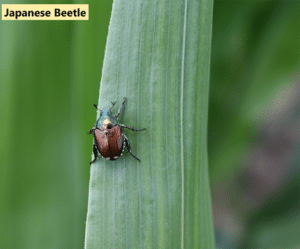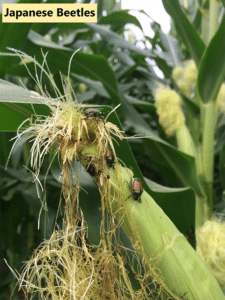 The Japanese beetle is a scarab beetle commonly found in Tennessee. This beetle can be a pest of gardens, trees, shrubs, turf grass and agricultural fields. Adults have a bright metallic green head and thorax with copper-colored elytra (hardened wings) and a row of five spots of white hairs on each side of the abdomen below the wings. Japanese beetles injure corn by feeding on the fresh silks of developing ears. This feeding/clipping may interfere with kernel pollination if it occurs during the first week of silking. Drought conditions may exacerbate this issue.
The Japanese beetle is a scarab beetle commonly found in Tennessee. This beetle can be a pest of gardens, trees, shrubs, turf grass and agricultural fields. Adults have a bright metallic green head and thorax with copper-colored elytra (hardened wings) and a row of five spots of white hairs on each side of the abdomen below the wings. Japanese beetles injure corn by feeding on the fresh silks of developing ears. This feeding/clipping may interfere with kernel pollination if it occurs during the first week of silking. Drought conditions may exacerbate this issue.
Sampling: Corn fields should be checked the first week of silking to determine the presence of Japanese beetles and other pests of corn. Walk in a U-shaped pattern over the field looking for beetles feeding on silks. Sample 10 plants in 10 locations throughout the field.
Treatment Thresholds: Treat when three or more beetles are found per ear during the first week of silking. Infestations are usually worse along field margins.
Management options
| Insecticide (Trade Names) for JAPANESE BEETLE | Lb Active Ingredient per Acre | Amount Formulation per Acre | Performance Rating |
| bifenthrin (Brigade 2E, Discipline 2E, Fanfare 2E) | 0.047 - 0.1 | 3 - 6.4 oz | 8 |
| carbaryl (Sevin XLR Plus 4) | 1 - 2 | 32 - 64 oz | 6 |
| β-cyfluthrin (Baythroid XL 1) | 0.0125 - 0.022 | 1.6 - 2.8 oz | 8 |
| γ-cyhalothrin (Declare 1.25) | 0.01 - 0.015 | 1.02 - 1.54 oz | 8 |
| λ-cyhalothrin (Warrior II) | 0.02 - 0.03 | 1.28 - 1.92 oz | 8 |
| Z-cypermethrin (Mustang Maxx 0.8E) | 0.017 - 0.025 | 2.75 - 4 oz | 8 |

